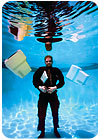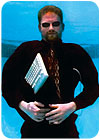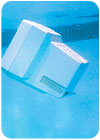
So you’ve been awarded the contract for the design of a facility that will include a swimming pool. Should you just hire a pool design firm as a sub? My recommendation is that you, a design professional, need to know enough about pool design to effectively evaluate the abilities of any pool designer that you might consider adding to your design team. If you are able to do that, you probably have enough resources on your staff in-house (plumbing designers, mechanical/ electrical engineers, and structural engineers) to limit your need for outside assistance. Information regarding specialty products such as water features or water playground structures can be acquired through the manufacturer.
If you aren’t experienced in pool design, I believe that it is well worth your time to develop this area of expertise. A great many pool designs are sorely lacking in proper plumbing details. Electrical requirements often are missed or require change orders after a project is bid. Much of this results from lack of input from a professional designer.
The purpose of any quality pool design should be to maximize the safety of the patrons, while providing an enjoyable water-based environment. Your design approach should be to develop a system that provides maximum performance as to water quality. Both the clarity of the water and its bacterial safety are of primary concern. Potential hazards such as suction or limb entrapment, hair entanglement or tripping concerns must be examined. Of course, local Health Department Codes are designed to assure that these criteria are met, but codes merely provide minimum standards. A quality design should go well beyond minimum requirements.
When you look at the broad spectrum of approaches used for pool design, you should attempt to evaluate the major cost and performance differences between lower-quality equipment (such as the type used in hotel/motel/health club systems) and higher-end products used on major commercial pool installations. If the owners haven’t already made some of these assessments on their own, you should be prepared to appraise them of the pros and cons of available choices. They can then make an informed decision on the value they wish to place on the quality of the end product.
If you are designing a commercial installation for a high school, university, park district, or YMCA, there are basic components you need to understand. The piping systems will include a gutter that skims water off the top of the pool around the perimeter. Water from the gutter will flow by gravity to a surge tank. Main drain grates will be located at the bottom of the pool and be either direct-connected to circulation pump suction, or flow by gravity to the surge tank.
Board of Health Requirements
There are certain Board of Health requirements, beyond the scope of plumbing codes, that must be met. These include:Turnover Rate (minimum).Times per day a quantity of water, equal to the gallons in the pool and surge vessel, are pumped through the filtration and water treatment system (usually four times per day, or every six hours for a basic swimming pool; every two hours for a wading pool).
Filter Media Rate (FMR).Maximum rate in gpm/sq. ft. of filter surface area at which water is allowed to pass through various types of filters (per NSF Standard 50).
Maximum Pipe Velocities.Usually 5 to 8 feet per second (fps) in suction piping; 8 to 10 fps in piping returning filtered water to the pool.
Main Drain Velocities.Usually 1 to 1-1/2 fps; also free area of grate four times the area of connected pipe. Always more than one main drain connected hydraulically equal.
Main Drains/Inlets.Health codes will typically specify the locations for these circulation system components. Minimum distances from sides of the pool for main drain placement and required distances between each main drain grate and sump are mandated. Filtered water inlets will have spacing requirements. This is to ensure that there is proper distribution of chemically treated water.
Surge Vessel.These can take many forms. Some common types are concrete surge tanks buried under the pool deck, freestanding surge vessels and surge gutter trenches. Their purpose is to capture the dirty water coming off the top of the pool during use, and return it to the pool through the filtration and chemical treatment systems. The water displaced by the swimmers must be held in a reserve until the pool is again unoccupied. Sending surge or gutter water to waste is no longer allowed.
Pump Available Head.Circulation pump performance may be mandated to a minimum Total Dynamic Head (TDH) capacity at minimum design flow required. This can be 70 feet to 80 feet TDH and usually varies by type of filter system used.
Basic Components
The basic components of a swimming pool mechanical design are: the filter, pump, flow meter, heaters, and chemical control/delivery systems. Depending on the type of filter selected, a hair and lint strainer also may be required upstream of the circulation pump. For each component there are several choices available, so research into the advantages of each, as they apply to your project conditions, should be closely examined.
Filtration Types
Vacuum Sand or DE.Vacuum systems get their name from the fact that water to be filtered is “pulled” by the circulation pump through the filter vessel. An open rectangular filter is situated upstream of the circulation pump. The pump creates a vacuum at pump suction, allowing atmospheric pressure to actually push the dirty water through the bed of sand or, depending on the type of filter, the filter elements coated with diatomaceous earth (DE). A hair and lint strainer is not required for these systems since the filter performs that function. The FMR through these types of filters is usually 10 gpm/sq. ft. for vacuum sand, and 1 to 1-1/2 gpm/sq. ft. through vacuum DE. Particle capture size is approximately 10 to 15 microns for sand, and 1 to 4 microns for DE, depending on the permeability of the product used.Hi-Rate Sand.Pump is placed upstream of a closed filter vessel. This type of filter preferably has a top distribution manifold that evenly distributes pool water over the sand bed. As the dirty water flows through the sand, debris is captured in the interstitial spaces between the sand particles. A bottom collection manifold allows passage of the filtered water, while not allowing sand particles into the return water. FMR for hi-rate sand filters is usually 15 to 20 gpm/sq. ft. These systems consume a good deal of water due to the required cleaning process. A pumped backwash, at 15 gpm/sq. ft. of filter area, requires substantial waste water handling or storage capacity. Particle capture size is approximately 15 to 20 microns clean and 10 to 15 microns loaded or prior to backwash.
Pressure or Regenerative DE.This filter is a closed vessel with internal elements coated with DE media. Pressure DE filters are termed “static cake” filters because, once they are charged with an initial coating of DE, the coating remains in place until it is backwashed off of the filter elements and replaced with new media. Regenerative DE filters reposition the initial charge of DE, usually on a timed basis, to effectively use all of the surfaces of the media before a DE change is made. A normal result of this process is longer filter cycles. FMRs for these filters are listed according to their NSF Standard 50 testing (usually 1-1/2 gpm/sq. ft.). Particle capture size is approximately 1 to 4 microns.
Circulation Pumps
Flooded Suction.This type of end-suction centrifugal pump should only be used when it can be installed below pool-operating water level. There are installations where they are placed on-grade and, supposedly, a check valve or foot valve is used to maintain a filled suction pipe. These installations are always operationally problematic. Flooded suction pumps are not designed to effectively evacuate air. Once the check or foot valve gets jammed by a foreign object, re-priming the pump is almost impossible.Self-Priming.These pumps are designed for installations where the equipment room is above pool water level. Selection should take into account the lift required for the application, as it relates to required net positive suction head. Self-priming pumps are effective at passing air during the priming process, but care must be taken to never operate them dry. A check valve in the suction piping (on the vertical run of pipe as it drops down to the surge tank) is helpful during the priming process.
One of the primary mistakes found in the use of these pumps is improper placement in the surge tank. As a starting point, you should examine the recommendations for basic sump design from theHydraulic Institute Standards, 14th Edition(1983).
Chemical Control
The area of chemical treatment is a very demanding subject. Virtually all current pool designs incorporate an automatic chemical controller with automated feed systems for pH control chemicals, as well as various sanitizers/oxidizers. Proper levels of disinfectant, as well as code-mandated pH levels, must be continuously maintained. Codes, for all but one or two states, require circulation pumps and chemical treatment systems to be operated 24 hours a day.Information on basic industry standards can be obtained from the Association of Pool and Spa Professionals (APSP). A description of the function of various treatment chemicals, as well as a good overview of water chemistry basics, can be found in the National Swimming Pool Foundation (NSPF)Certified Pool-Spa Operator® Handbook(2004). That being said, local codes take precedence over any of these guidelines.
Some basic cautions regarding chemicals used are: 1) the use of stabilized chlorine products is undesirable for indoor pool applications; and 2) the use of CO2 for indoor pool pH control can be problematic. The CO2 forms carbonic acid when it mixes with the water. It also raises Total Alkalinity (TA) of the pool water. The carbonic acid is a weak acid. Higher TA requires increasing amounts of CO2 to lower pH. It can become a troublesome cycle leading to scale-forming water conditions.

Heating Systems
Typical heating systems are double-wall heat exchangers (steam or hot water), gas-fired heaters or electric heaters. Electric heaters are very uncommon on large pools. Their use is usually limited to spas or hot tubs. If gas-fired heaters are your choice, consider sealed combustion units. The ambient air in the pool equipment room is usually quite corrosive. Therefore, impure combustion air in an atmospheric heater will cause premature failure of the heat exchanger.The real key to effective swimming pool system design centers on accurate level control and maintaining minimum required flow rates/turnover rates. Both affect proper skimming action. Although piping for main drains and gutters is normally required to be such that it can handle 100% of the minimum flow rate at or below maximum pipe velocities, the skimming action at the perimeter gutter is most essential. In times of activity, debris is being introduced into the pool water at the top of the pool. This is the water we would like to capture and put through the filtration and chemical treatment system first. Accurate and responsive level control is the best means of accomplishing this.
The topic of level control schemes is very involved and would consume too much space here to give the choices a proper examination. You may choose to use a simple float-operated butterfly valve on the main drain piping as it enters the surge tank, or you may opt for much more accurate control. This would require the use of pneumatically operated, positive shutoff, main drain modulating valves with a “bubbler” or differential pressure controller. Suffice it to say that level control options are worthy of some informed investigation.
Incorporating Water Features
There are far too many different types of playground features, spray features, slides, flumes, vortexes, etc., to give them any type of detailed examination here. Instead, I would like to offer some ideas on what should be considered when incorporating these into a pool design.The primary concern is user safety. Will the structures themselves create tripping hazards on the pool deck, or limit free movement around the pool deck? Can the area near the bottom of a slide or flume be kept free of bathers so that patrons exiting the play feature will not strike fellow swimmers?
Will separate pumps be used for each feature? If so, from where will they draw their water? If it will be from the dirty water in the surge tank, how will you protect the pump from being plugged with debris? This same dirty water also has the potential to plug any play feature that incorporates small orifices for spray action.
If water will be drawn directly from the pool, the same dirty water concerns exist. An additional concern is to protect from possible hair, limb or suction entrapment of the patrons. Some codes may require use of a vacuum breaker open to atmosphere through a sizeable pipe connection at pump suction. Exercise caution in the use of these. Many times they are adjusted improperly. If they are triggered inadvertently, and the operator is not aware that there is an open connection at pump suction, cavitation may destroy the circulation pump over a long period of time.
If these water features are part of the design of an indoor facility, you might consider some type of sanitation of the water being atomized into the pool facility atmosphere. This can be a good use for ozone or other non-chlorine means of oxidation.
Hopefully, this discussion will give you an idea of the areas of expertise you need to develop in order to become proficient in proper pool design. There are many approaches that will accomplish the same basic end result. Just be sure to place the well-being of the end user first.